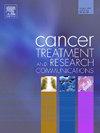The prognostic role of circulating CA19–9 and CEA in patients with colorectal cancer
IF 2.4
Q3 Medicine
引用次数: 0
Abstract
Background
Carcinoembryonic antigen (CEA) is the only prognostic circulating biomarker used in clinical practice for recurrence free (RFS), progression free (PFS) and overall survival (OS) in patients with colorectal cancer (CRC). Not all CRC tumors express this protein and carbohydrate antigen (CA)19–9 has been proposed as an adjunctive in prognostication. We aimed to test if CA19–9 yielded additional information to CEA regarding prognosis.
Patients and methods
We included 886 patients with CRC across eight clinical cohorts. Preoperative serum samples were collected from 376 patients with stage I-III CRC and from 510 with metastatic (m)CRC before 1st (n = 233), 3rd (n = 178) and 3rd/4th (n = 99) line chemotherapy. CA19–9 and CEA were determined by routine assays, the values were log-2 transformed and entered as variables in Cox regression models with RFS (stage I-III), PFS and OS as the outcomes, adjusted for age, sex, and site of primary tumor and mutual adjustment between CA199 and CEA. Random effects meta-analyses were conducted for stage I-III,1st line, and 3rd/4th line mCRC cohorts separately.
Results
Meta-analyses showed that higher pre-treatment CA19–9 and CEA were associated with shorter RFS (CA19–9: hazard ratio per doubling of concentration (HR)=1.20, 95 % confidence interval (CI) 1.05–1.38; CEA: HR=1.22, 95 % CI 1.05–1.41) in stage I-III CRC. Only higher CEA was associated with shorter OS in 1st line mCRC (HR=1.07, 95 % CI 1.00-1.07).
Conclusion
CA19–9 might aid in identifying patients with a high risk of recurrence after primary radical resection. Further studies are needed to validate these findings.
循环CA19-9和CEA在结直肠癌患者预后中的作用
背景:癌胚抗原(CEA)是临床实践中唯一用于评估结直肠癌(CRC)患者无复发(RFS)、无进展(PFS)和总生存期(OS)的预后循环生物标志物。并非所有结直肠癌肿瘤都表达这种蛋白,碳水化合物抗原(CA) 19-9被认为是预测预后的辅助指标。我们的目的是测试CA19-9是否为CEA提供了关于预后的额外信息。患者和方法我们纳入了8个临床队列的886例结直肠癌患者。在第一次(n = 233)、第三次(n = 178)和第三/第四次(n = 99)化疗前,收集376例I-III期CRC患者和510例转移性(m)CRC患者的术前血清样本。常规测定CA19-9和CEA,将其值进行log-2转换,作为变量输入以RFS (I-III期)、PFS和OS为结果的Cox回归模型中,对年龄、性别、原发肿瘤部位进行调整,并在CA199和CEA之间进行相互调整。随机效应荟萃分析分别对I-III期、1线和3 /4线mCRC队列进行。结果荟萃分析显示,预处理前CA19-9和CEA越高,RFS越短(CA19-9:浓度加倍的风险比(HR)=1.20, 95%可信区间(CI) 1.05 ~ 1.38;CEA: HR=1.22, 95% CI 1.05-1.41)。在一线mCRC中,只有较高的CEA与较短的OS相关(HR=1.07, 95% CI 1.00-1.07)。结论ca19 - 9可能有助于鉴别原发性根治性肿瘤术后复发的高危患者。需要进一步的研究来验证这些发现。
本文章由计算机程序翻译,如有差异,请以英文原文为准。
求助全文
约1分钟内获得全文
求助全文
来源期刊

Cancer treatment and research communications
Medicine-Oncology
CiteScore
4.30
自引率
0.00%
发文量
148
审稿时长
56 days
期刊介绍:
Cancer Treatment and Research Communications is an international peer-reviewed publication dedicated to providing comprehensive basic, translational, and clinical oncology research. The journal is devoted to articles on detection, diagnosis, prevention, policy, and treatment of cancer and provides a global forum for the nurturing and development of future generations of oncology scientists. Cancer Treatment and Research Communications publishes comprehensive reviews and original studies describing various aspects of basic through clinical research of all tumor types. The journal also accepts clinical studies in oncology, with an emphasis on prospective early phase clinical trials. Specific areas of interest include basic, translational, and clinical research and mechanistic approaches; cancer biology; molecular carcinogenesis; genetics and genomics; stem cell and developmental biology; immunology; molecular and cellular oncology; systems biology; drug sensitivity and resistance; gene and antisense therapy; pathology, markers, and prognostic indicators; chemoprevention strategies; multimodality therapy; cancer policy; and integration of various approaches. Our mission is to be the premier source of relevant information through promoting excellence in research and facilitating the timely translation of that science to health care and clinical practice.
 求助内容:
求助内容: 应助结果提醒方式:
应助结果提醒方式:


